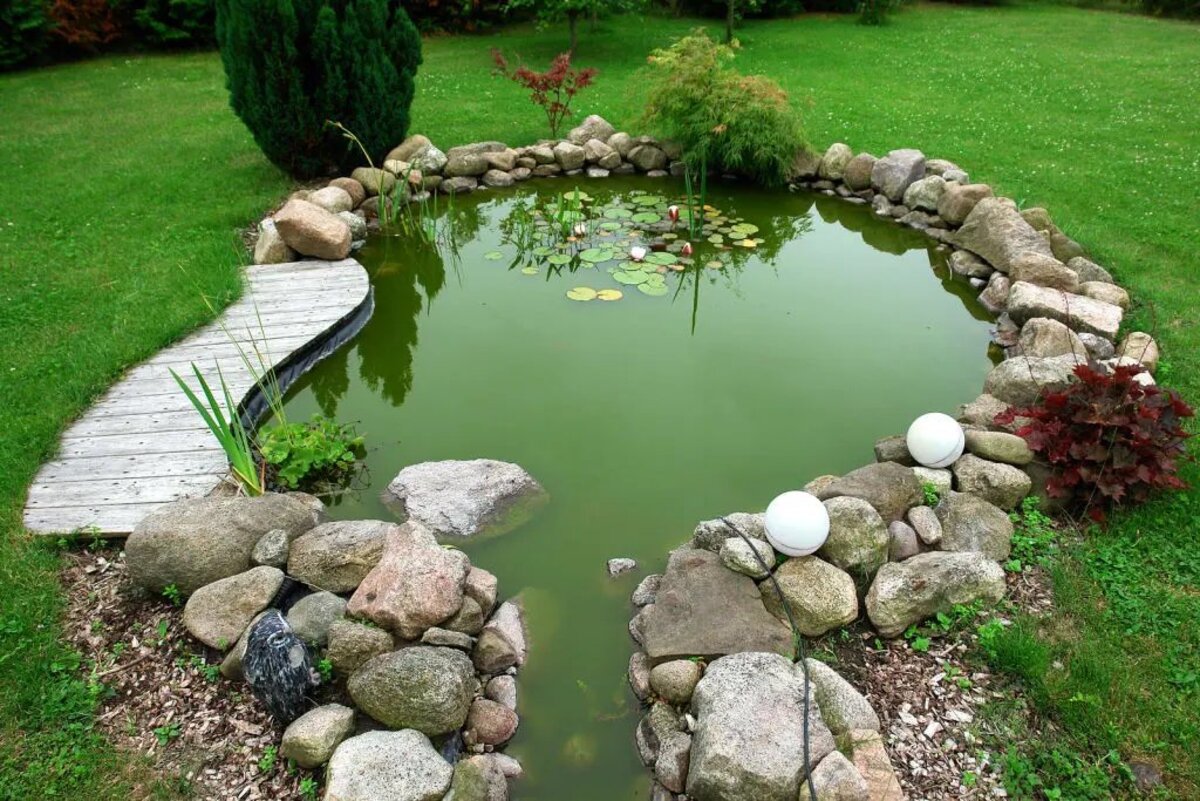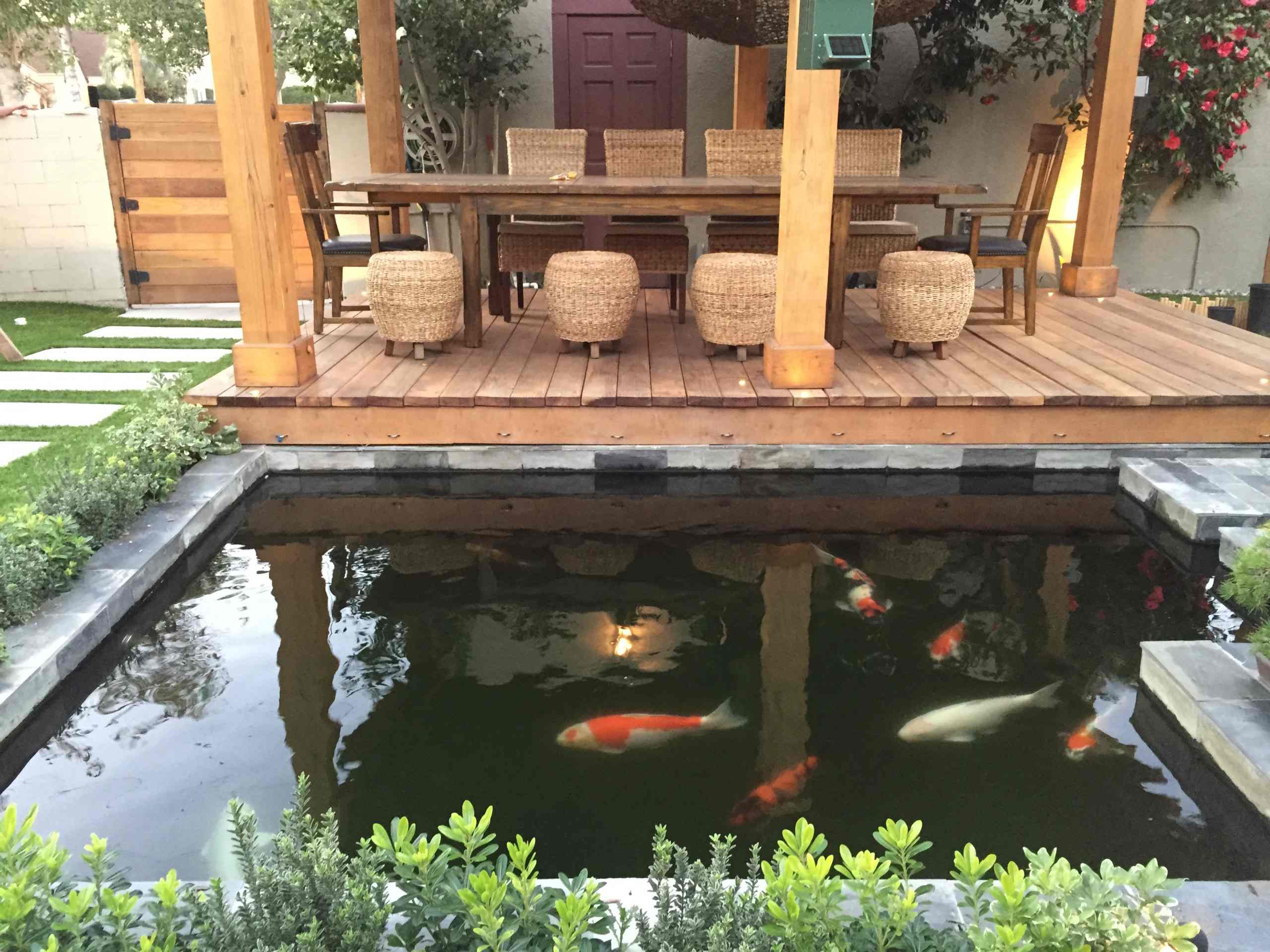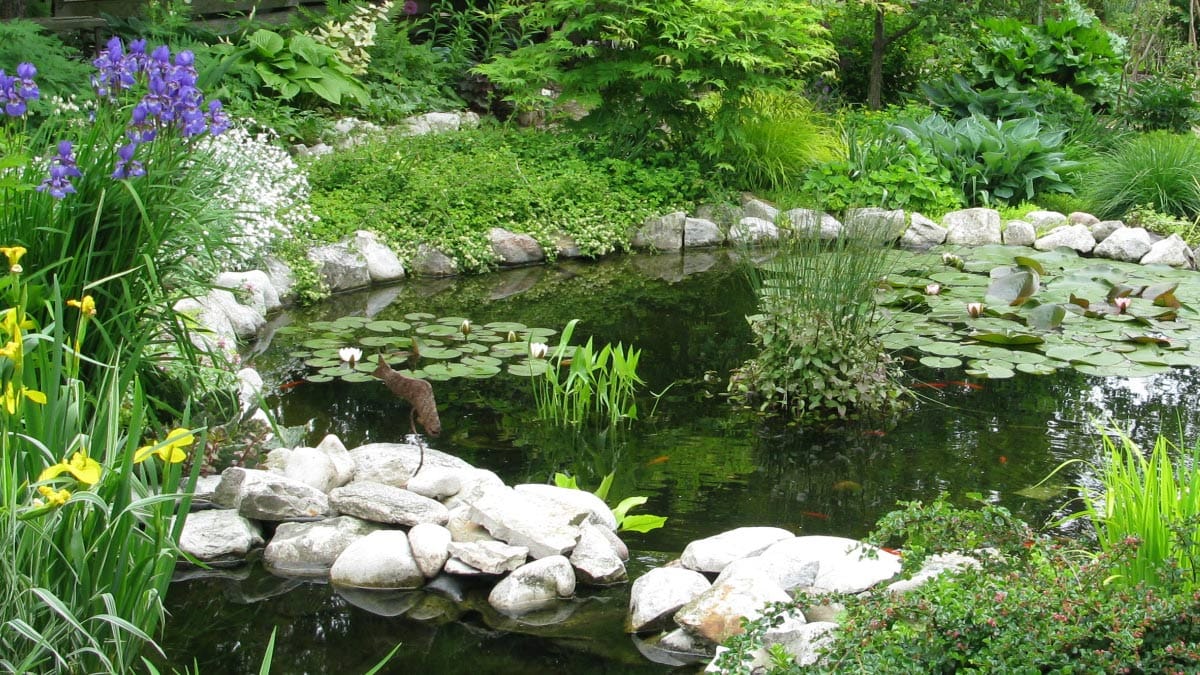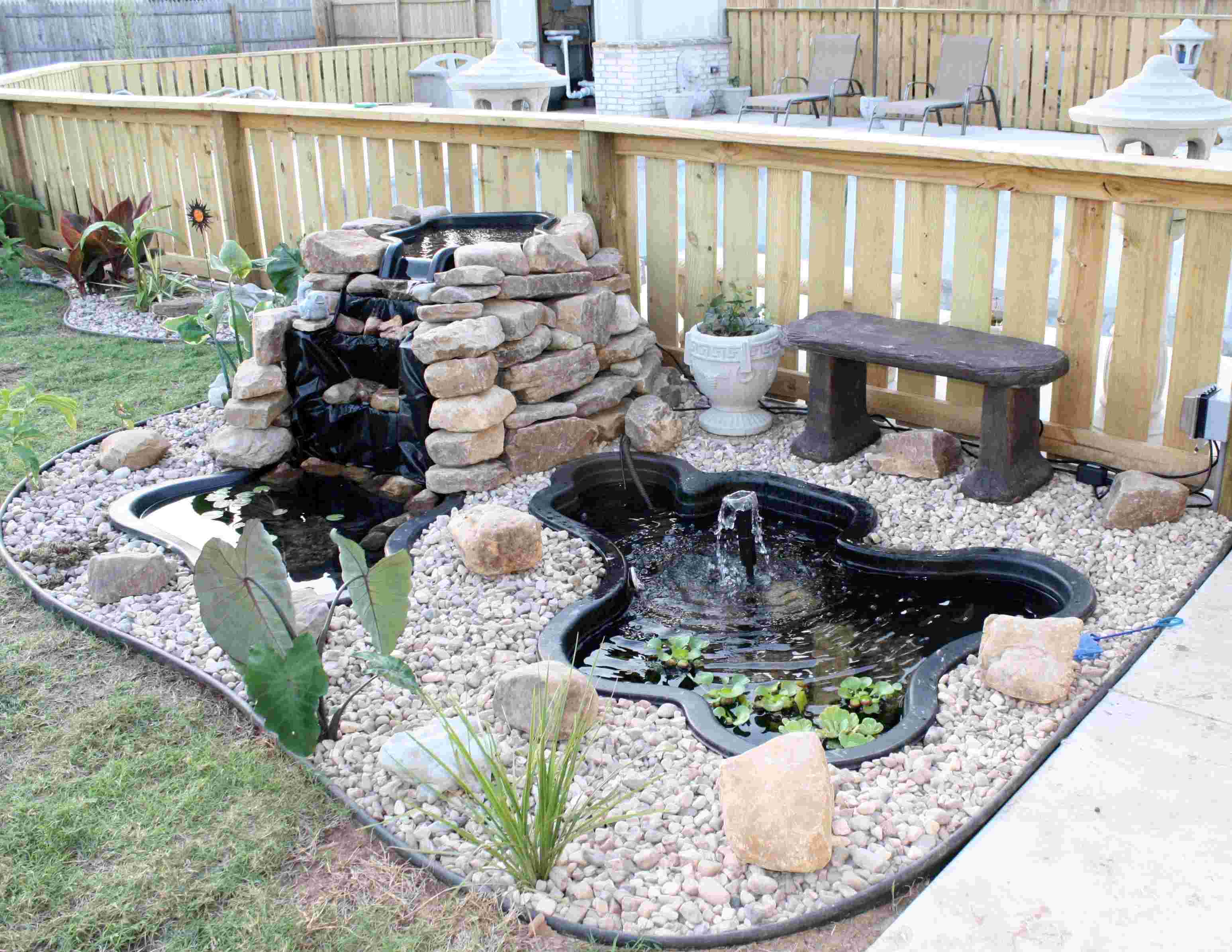Home>Gardening Tips and Tricks>Eco-Friendly Gardening>Where To Place Permaculture Ponds


Eco-Friendly Gardening
Where To Place Permaculture Ponds
Published: February 15, 2024
Discover the best locations to install permaculture ponds for eco-friendly gardening. Maximize sustainability and create a thriving ecosystem in your garden
(Many of the links in this article redirect to a specific reviewed product. Your purchase of these products through affiliate links helps to generate commission for Chicagolandgardening.com, at no extra cost. Learn more)
Table of Contents
Introduction
Permaculture ponds are a sustainable and eco-friendly addition to any garden or landscape. They offer numerous benefits, both for the environment and for the overall health and productivity of your plants and crops. By creating a balanced ecosystem within your pond, you can promote biodiversity, conserve water, and provide a habitat for beneficial insects, birds, and amphibians.
When it comes to placing permaculture ponds, careful consideration is required. The location of the pond plays a crucial role in its functionality and success. Factors such as sunlight exposure, proximity to structures, and compatibility with the surrounding landscape should be taken into account. To ensure the best results, it’s important to find an ideal location that meets the specific needs of your permaculture system.
In this article, we will explore the benefits of permaculture ponds and discuss the factors to consider when selecting the perfect spot for them. We will also present six ideal locations where you can place your permaculture pond to maximize its benefits within your gardening and landscaping endeavors.
Benefits of Permaculture Ponds
Permaculture ponds offer a wide range of benefits, making them an essential component of eco-friendly gardening and sustainable land management. Here are some of the key advantages of incorporating permaculture ponds into your landscape:
- Water Conservation: Permaculture ponds act as natural reservoirs, collecting and storing rainwater. This helps to mitigate water runoff and reduces the strain on local water resources. Additionally, the water within the pond can be used for irrigation purposes, reducing the need for additional water sources.
- Biodiversity Promotion: Permaculture ponds create a diverse and thriving ecosystem. They provide habitat and shelter for a wide variety of aquatic plants, insects, birds, and amphibians. This helps to promote biodiversity, attracting beneficial organisms that contribute to pest control and pollination.
- Nutrient Cycling: Permaculture ponds act as a natural recycling system. Organic matter from the surrounding garden or landscape, such as fallen leaves and excess plant material, can be added to the pond. These materials decompose and release valuable nutrients that can be absorbed by plants, creating a nutrient-rich environment.
- Temperature Regulation: Permaculture ponds help to regulate temperature in their surroundings. The water acts as a heat sink, absorbing excess heat during hot summer days and releasing it slowly during cooler nights. This creates a more favorable microclimate for plants and animals, reducing the risk of temperature stress.
- Aesthetic Appeal: Permaculture ponds enhance the visual appeal of your garden or landscape. They add a natural and tranquil element, creating a sense of serenity and beauty. The reflections and movement of water create a soothing atmosphere, providing a haven for relaxation and contemplation.
Incorporating permaculture ponds into your gardening practices not only benefits the environment but also enhances the overall health and productivity of your garden. By creating a harmonious balance between water, plants, and wildlife, permaculture ponds contribute to the creation of a thriving and sustainable ecosystem.
Factors to Consider for Pond Placement
When determining the placement of your permaculture pond, several factors should be taken into consideration. These factors will help ensure the optimal functionality and success of your pond, as well as its integration into the surrounding landscape. Here are some key factors to consider:
- Sunlight Exposure: Evaluate the amount of sunlight that the proposed location receives throughout the day. Most aquatic plants and organisms require a certain amount of sunlight for photosynthesis and growth. Choose a spot that receives adequate sunlight, but also consider providing some shade to prevent excessive algae growth.
- Proximity to Structures: Consider the proximity of the pond to buildings, trees, and other structures. Ensure that the pond is not too close to structures that may be affected by soil erosion or water overflow. Additionally, avoid placing the pond near trees with aggressive roots that may damage the pond liner.
- Drainage: Ensure there is proper drainage in the selected location to prevent waterlogging. The pond should not be situated in an area with poor drainage, as it can lead to stagnant water and potential issues with mosquitoes and other pests.
- Accessibility: Consider the accessibility of the pond for maintenance purposes. It should be easily reachable for tasks such as cleaning, adding aquatic plants, and removing debris. Accessible placement will make it more convenient to maintain and enjoy the pond.
- Landscaping Integration: Integrate the pond seamlessly into the overall landscape design. Consider how the pond will blend with existing garden features and vegetation. Take into account the visual impact and ensure that the pond enhances the aesthetic appeal of the surrounding area.
- Safety: Ensure the safety of children and pets by considering their proximity to the pond. If you have small children or pets, it may be advisable to install safety features, such as a fence or cover, to prevent accidental falls or access to the pond.
By considering these factors, you can select an ideal location for your permaculture pond that maximizes its benefits and integrates seamlessly into your garden or landscape. Remember to plan ahead and carefully assess each factor before finalizing the placement of your pond.
Ideal Locations for Permaculture Ponds
While the placement of permaculture ponds depends on the specific needs of your gardening and landscaping endeavors, here are six ideal locations to consider:
- Backyard Placement: Placing a permaculture pond in your backyard allows for easy access and visibility. It can be a focal point in your outdoor space and provide a peaceful retreat for relaxation. Consider creating a natural edge with rocks and plants to blend the pond with the surrounding landscape.
- Garden Placement: Integrate a permaculture pond into your vegetable or flower garden. This location allows for easy access to water for irrigation purposes and provides a natural habitat for beneficial insects that can contribute to pest control. The pond can also add visual interest and enhance the overall aesthetic of your garden.
- Orchard Placement: Placing a permaculture pond in or near your orchard can provide additional water sources for irrigation. The pond can attract pollinators and beneficial insects, creating a more balanced ecosystem and potentially increasing fruit yields. Consider incorporating a small waterfall or fountain feature for added beauty and aeration.
- Livestock Placement: Installing a permaculture pond in an area where livestock graze can provide them with a source of fresh water. It also benefits the surrounding land by reducing soil erosion caused by the animals. Ensuring proper fencing and vegetation buffers can prevent contamination of the pond and protect the livestock.
- Forest Placement: If you have a wooded area on your property, consider placing a permaculture pond at the edge of the forest. This location can create a transitional zone between the forest and open areas, attracting wildlife and promoting biodiversity. The pond can also serve as a reflection pool, capturing the beauty of the surrounding trees.
- Rooftop Placement: For those with limited outdoor space, a rooftop permaculture pond can be a unique and innovative option. By utilizing waterproofing techniques and proper structural support, you can create a small pond on your rooftop. This location allows for efficient use of space, provides insulation benefits, and contributes to rainwater harvesting.
These are just a few examples of ideal locations for permaculture ponds. It’s important to assess your specific needs, available space, and environmental conditions to determine the best placement for your pond. Remember to consider factors such as sunlight exposure, proximity to structures, and integration with the surrounding landscape when selecting the perfect location for your permaculture pond.
Backyard Placement
Placing a permaculture pond in your backyard is a popular and convenient option. It allows you to easily access and enjoy the benefits of the pond while adding a beautiful focal point to your outdoor space. Here are some key considerations for backyard placement:
Accessibility: Backyard placement ensures easy access to the pond for maintenance and enjoyment. You can easily clean the pond, add aquatic plants, and observe the wildlife that it attracts.
Visibility: A permaculture pond in your backyard becomes a visual centerpiece that enhances the overall aesthetic appeal of your outdoor space. It adds a sense of serenity and tranquility, creating a peaceful oasis for relaxation.
Integration: To ensure seamless integration with the surrounding landscape, consider using natural elements such as rocks, stones, and native plants to create a natural edge around the pond. This helps to blend the pond with the rest of your backyard while providing a habitat for beneficial wildlife.
Water Features: Enhance the visual appeal of your backyard pond by incorporating water features, such as a small waterfall or fountain. This not only adds beauty but also helps in aerating the water, promoting oxygenation and supporting aquatic life.
Seating Areas: Create seating areas around the pond to fully enjoy its benefits. You can place benches or outdoor furniture nearby, allowing you to relax, read a book, or simply observe the mesmerizing reflections and movements of the water.
A backyard permaculture pond brings multiple benefits. It conserves water, promotes biodiversity, and acts as a natural cooling agent. It attracts beneficial insects and birds, contributing to the overall health and productivity of your backyard ecosystem.
Remember to assess the sunlight exposure in your backyard when deciding on the location. Most aquatic plants require a certain amount of sunlight each day for photosynthesis and growth. Additionally, consider the proximity to structures, ensuring that the pond is at a safe distance to prevent water overflow or erosion issues.
By carefully planning and designing the placement of your backyard permaculture pond, you can create a harmonious and sustainable ecosystem right at your doorstep.
Garden Placement
Integrating a permaculture pond into your garden is a strategic placement that offers numerous benefits for both your plants and the overall ecosystem. Here are some key considerations for garden placement of a permaculture pond:
Irrigation Convenience: Placing a pond in your garden allows for easy access to water for irrigation purposes. You can use the pond water to provide a sustainable and efficient watering system for your plants, especially during dry spells or when water resources are limited.
Biodiversity and Pest Control: A pond in the garden promotes biodiversity by attracting beneficial insects, birds, and amphibians. These organisms play a vital role in pollination, pest control, and overall ecosystem health. They can help control garden pests naturally, reducing the need for harmful chemical pesticides.
Visual Appeal: A permaculture pond in the garden adds aesthetic value and serves as a beautiful focal point. It creates a serene and relaxing atmosphere, enhancing the overall ambiance of your garden. The reflections and movements of the water offer a captivating visual display and an enjoyable space for contemplation.
Integration with Planting Design: When considering garden placement, ensure that the pond complements the existing plantings and garden design. It should seamlessly blend with the surrounding vegetation and hardscape elements. Incorporating aquatic plants and water-loving species around the pond can create a natural transition between the land and water ecosystems.
Edible Aquatic Plants: Garden placement allows for the integration of edible aquatic plants, such as watercress or water chestnuts. These plants not only add visual interest but also provide a source of nutritious food right in your own backyard. They contribute to a sustainable and self-sufficient garden ecosystem.
When choosing the location within your garden, take into consideration the amount of sunlight the area receives. Most aquatic plants require sufficient sunlight for growth and photosynthesis. Additionally, ensure the pond is visible and easily accessible for maintenance purposes, such as planting, pruning, and cleaning.
A well-designed permaculture pond in the garden creates a harmonious and self-sustaining ecosystem. It conserves water, attracts beneficial organisms, and enhances the productivity and beauty of your garden. Through careful planning and thoughtful integration, a garden pond becomes a valuable asset for any eco-friendly gardener.
Orchard Placement
Integrating a permaculture pond within or near your orchard can provide numerous benefits to your fruit trees and the surrounding ecosystem. Here are some key considerations for placing a permaculture pond in your orchard:
Water Source for Irrigation: Placing a pond within your orchard provides a convenient and sustainable water source for irrigation. You can use the collected rainwater or divert excess water from the pond to keep your fruit trees well-hydrated, especially during dry periods. This reduces reliance on external water sources and promotes a self-sufficient orchard ecosystem.
Promoting Pollination: A permaculture pond in the orchard attracts pollinators such as bees and butterflies. These insects are essential for cross-pollination, enhancing the fruit set and overall yield of your orchard trees. The proximity of the pond to the trees creates a favorable environment for pollinators to thrive and contribute to the health of your orchard ecosystem.
Biodiversity Enhancement: The pond attracts a diverse range of organisms, including beneficial insects, birds, and amphibians. This supports an ecosystem that naturally controls pests and improves the overall health of your orchard. Birds can help control insect populations, while amphibians such as frogs and toads consume garden pests, reducing the need for chemical intervention.
Microclimate Regulation: A permaculture pond in the orchard helps moderate the microclimate, creating a more favorable environment for the fruit trees. The water in the pond acts as a heat sink, absorbing excess heat during hot days and releasing it during cooler nights. This temperature regulation can help protect your trees from extreme temperatures and reduce stress on their growth and productivity.
Visual Appeal and Aesthetic Value: Integrating a pond into your orchard adds visual interest and enhances the overall aesthetic appeal of the landscape. The reflections on the water surface and the presence of aquatic plants create a tranquil and beautiful setting within your orchard. It can serve as a focal point that adds charm and character to your growing space.
When determining the location of the permaculture pond in the orchard, ensure it is within a reasonable distance from the fruit trees. Consider the space available while ensuring the pond does not pose any risk of water overflow or potential damage to the trees’ root systems. Additionally, plan the surrounding vegetation by incorporating water-loving plants or creating a buffer zone to prevent soil erosion and maintain water quality.
A well-placed permaculture pond within your orchard supports a sustainable and thriving ecosystem. It conserves water, enhances pollination, attracts beneficial organisms, and contributes to the long-term health and productivity of your fruit trees.
Livestock Placement
Placing a permaculture pond in an area where livestock graze can provide multiple benefits for both the animals and the surrounding land. Here are some key considerations for livestock placement of a permaculture pond:
Water Source for Livestock: A permaculture pond serves as a natural water source for your livestock, providing them with fresh water to drink. Having a pond in their grazing area reduces their reliance on traditional water sources and ensures that they have access to water throughout the year.
Soil Erosion Control: Livestock can cause soil erosion with their constant movement and grazing. Placing a permaculture pond in the grazing area helps mitigate soil erosion by capturing and filtering runoff water. The pond acts as a sediment trap, preventing soil degradation and nutrient loss.
Nutrient Recycling: Livestock manure is a valuable resource for fertilizing the land. The placement of a permaculture pond allows for the recycling of nutrients. The manure can be composted and then added to the pond, where it breaks down naturally, releasing valuable nutrients that can be absorbed by aquatic plants. These plants, in turn, contribute to water quality improvement.
Habitat for Wildlife: A permaculture pond in the livestock area creates a habitat for various wildlife species. Birds, insects, amphibians, and other organisms are attracted to the water source, promoting biodiversity and contributing to the overall health of the ecosystem. The presence of diverse wildlife can help in pest control and enhance the biological balance of the area.
Fencing and Vegetation Buffers: When placing a pond in a livestock area, consider installing appropriate fencing to prevent the animals from entering and potentially damaging or polluting the pond. Additionally, establish vegetation buffers around the pond’s perimeter to filter any runoff that may contain contaminants.
It’s important to monitor the water quality of the permaculture pond in the livestock area regularly. Livestock activities can contribute to potential contamination of the water, so implementing measures to maintain water quality is essential. This may include ensuring proper drainage, minimizing manure runoff, and periodically testing the water for any imbalances or pollutants.
A well-placed permaculture pond in the livestock area not only provides a vital water source for the animals but also contributes to soil conservation, nutrient recycling, and biodiversity enhancement. It encourages a more sustainable and environmentally friendly approach to land management and animal husbandry.
Forest Placement
Placing a permaculture pond at the edge of a forest or within a wooded area can have numerous benefits for the ecosystem and create a harmonious balance between land and water. Here are some key considerations for forest placement of a permaculture pond:
Transitional Zone: A permaculture pond in a forest creates a transitional zone between the land and water ecosystems. This location attracts a diverse range of wildlife, providing a valuable habitat and promoting biodiversity. The pond acts as a meeting point for forest-dwelling organisms and those that thrive in wetland environments.
Mirror Reflecting Pool: Placing a pond in a forest creates an enchanting mirror reflecting pool. The surrounding trees are beautifully mirrored in the still water, creating a captivating and serene atmosphere. This natural beauty makes the forest pond a perfect spot for peaceful contemplation and enjoying the scenic views.
Natural Cooling Effect: Forest placement of a permaculture pond helps regulate temperature in the surrounding area. The shade from the trees, combined with the evaporative cooling effect of the water, creates a more comfortable microclimate during hot summer days. This can benefit both the pond’s ecosystem and nearby plant life.
Habitat Creation: Forest ponds provide habitat for a variety of organisms, including amphibians, insects, and birds. Frogs, toads, and dragonflies are particularly drawn to forest ponds. These creatures help control pests and contribute to the overall health and balance of the forest ecosystem.
Erosion Prevention: Placing a pond at the edge of a forest can assist in preventing erosion. It helps capture and slow down runoff, allowing sediment to settle and preventing soil erosion within the forest area. The pond acts as a natural filter, promoting the retention of nutrients and protecting the ecosystem from degradation.
When choosing the location for a permaculture pond in a forest, consider the existing water flow patterns and natural depressions. Look for areas where water naturally collects or areas with slightly lowered elevation that can serve as a potential pond site. Thin out any dense vegetation that may hinder the establishment of the pond and maintain a healthy balance between sunlight and shade to support the growth of aquatic plant life.
A permaculture pond in a forest not only adds visual charm but also contributes to the overall health and diversity of the ecosystem. It harmonizes the elements of land and water, providing a sanctuary for wildlife and creating a tranquil and captivating feature within the forest landscape.
Rooftop Placement
Consider placing a permaculture pond on your rooftop for a unique and innovative approach to eco-friendly gardening. Rooftop placement offers several advantages and allows you to maximize your space efficiently. Here are some key considerations for rooftop placement of a permaculture pond:
Space Optimization: Rooftop placement of a permaculture pond allows you to make the most of limited space. Utilizing the otherwise unused rooftop area to create a pond ensures optimal use of available land and promotes sustainable gardening practices in urban environments.
Rainwater Harvesting: Rooftop ponds can serve as rainwater harvesting systems. The pond collects rainwater from the rooftop, reducing runoff and allowing you to utilize this precious resource for irrigating plants and minimizing reliance on municipal water supplies.
Insulation Benefits: The presence of a permaculture pond on your rooftop can provide added insulation for your building. The water in the pond helps regulate temperature by absorbing heat during hot weather and releasing it slowly during cooler periods. This can contribute to energy savings and improve the overall energy efficiency of the building.
Wildlife Attraction: Even on a rooftop, a permaculture pond can attract wildlife such as bees, butterflies, and small birds. These insects and birds contribute to pollination and add vibrancy to your rooftop ecosystem. Consider adding vegetation around the pond to provide additional habitat and food sources for these beneficial creatures.
Structural Support and Waterproofing: Before creating a rooftop pond, ensure that the structure can support the weight of the water and the pond’s components. Waterproofing is also crucial to prevent leakage and potential damage to the building. Consult with a professional to ensure the safety and integrity of your rooftop pond.
When designing a permaculture pond on your rooftop, consider the size and shape that fits your available space. Create a suitable depth for the pond to accommodate aquatic plants and ensure proper water circulation. Include features like a small fountain or waterfall for aesthetic appeal and better oxygenation of the water.
Keep in mind that rooftop placement may require additional maintenance, such as regular cleaning and monitoring for leaks. It is essential to address these maintenance needs to ensure the long-term success and functionality of your rooftop permaculture pond.
A rooftop permaculture pond is a creative and efficient way to bring the benefits of a pond to urban environments. It allows for rainwater harvesting, energy conservation, and wildlife attraction, while also adding an element of natural beauty to your rooftop space.
Conclusion
Permaculture ponds are incredible additions to any landscape, providing numerous benefits for both the environment and your gardening endeavors. They promote water conservation, biodiversity, and nutrient cycling while enhancing the visual appeal and functionality of your outdoor space. The placement of a permaculture pond plays a vital role in its success, ensuring it integrates seamlessly into the surrounding landscape and meets the specific needs of your eco-friendly gardening practices.
When considering where to place your permaculture pond, there are several factors to take into account. Sunlight exposure, proximity to structures, drainage, accessibility, landscaping integration, and safety all need to be carefully considered. By considering these factors, you can determine the ideal location that maximizes the benefits of your permaculture pond.
We explored various ideal locations for permaculture ponds, including backyard placement, garden placement, orchard placement, livestock placement, forest placement, and even rooftop placement. Each location offers unique benefits and considerations that align with specific needs and goals.
Whether you choose to place your permaculture pond in a backyard, garden, orchard, livestock area, forest, or on a rooftop, each location presents an opportunity to create a thriving ecosystem. A well-placed permaculture pond conserves water, promotes biodiversity, regulates temperature, and enhances the overall aesthetic appeal of your landscape.
Remember to assess the specific conditions of your site, such as sunlight exposure, access to water sources, and environmental considerations, when determining the perfect placement for your permaculture pond. By thoughtfully designing and placing your pond, you can create a sustainable and beautiful ecosystem that nurtures your plants, attracts beneficial wildlife, and contributes to a greener and more eco-friendly environment.




